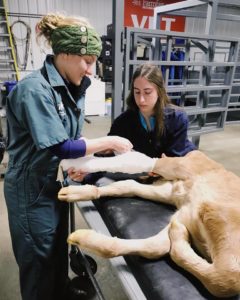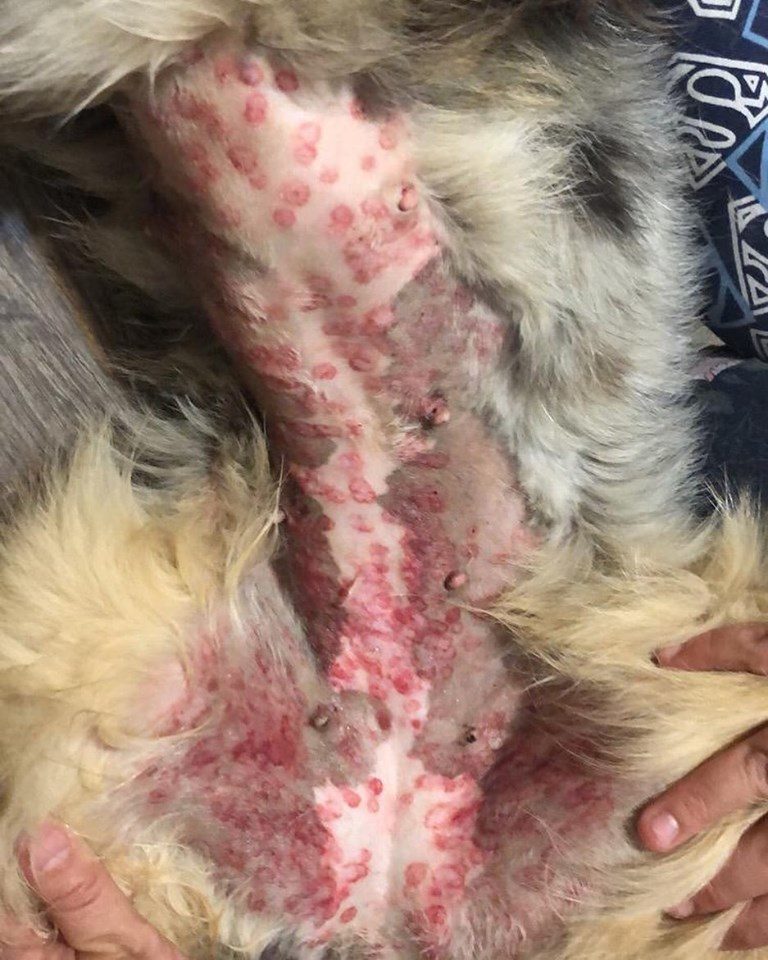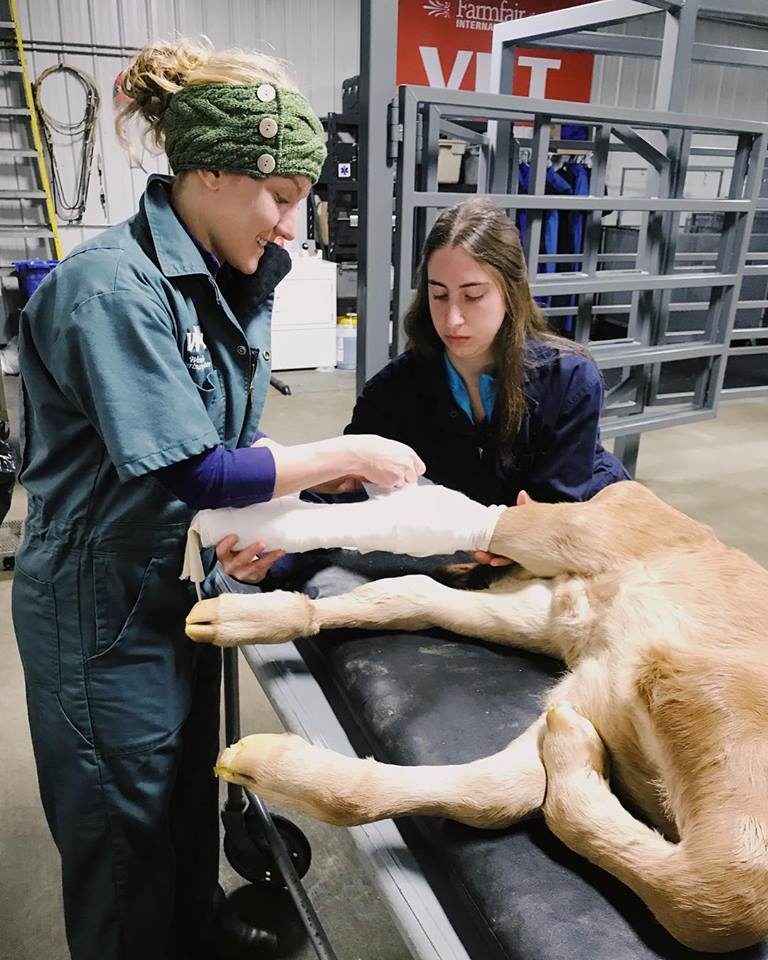Bug Season!
Please be aware, bug season is here!
We’ve been getting quite a number of calls from dog owners that their dog’s belly looks like this (see attached photo)
Unfortunately, there is not a lot you can do to prevent these black fly bites. If your dog runs around or lays in a tall grass area, they could get bit. They most commonly occur on the inside of the rear legs and on the belly. As bad as it can look, if this happens, most dogs will not notice and it should clear up quickly on its own. If your dog is bothered by it and is itchy, you can use an Elizabethan collar to prevent unwanted licking or a t-shirt to cover in the area. To help with the itching, try cool water baths and pet oatmeal shampoo. If itching is still severe, or you want more advice by please contact your veterinary clinic for further advice.
ph:780-349-3663
This type of fly is only around for a week or so every spring so hopefully they will be gone soon!

You’ve found a stray dog….now what?
In the event you find a stray dog, here are some tips and steps to follow.
The first and most important step, is to stay safe! The animal may be confused and scared, so be cautious. IF you choose to approach the animal, move slow and watch for signs of discomfort or aggression. DO NOT approach an animal if it is showing any signs of aggression.
Call your local bylaw office (see directory below). Depending on your municipality or county, they will generally provide stray dog services during day time hours, or if they are unavailable they will give you directions on what to do.
Once you have approached a pet in an attempt to reunite it with its owner, you are responsible. It is your responsibility to contact the appropriate bylaw and arrange with them the transportation to the correct impound facility. It is best to call bylaw immediately when dealing with a stray, they will ensure that your information is protected and the stray has the best chance of being reunited with its family.
We act as the “pound” for multiple counties and municipalities including The Town of Westlock, Westlock County, The Town of Athabasca, and Thorhild County. This means, many “found“ pets end up here at WVC. Be assured we do everything we can to reunite lost animals with their owners and treat them like family while they are in our care. When a stray is brought in it is scanned for a micro-chip, checked for tattoos or other identifying tags and given a wellness exam. If an animal has no tattoo/microchip upon arrival and an owner cannot be found they get vaccinated right away. A happy healthy pet will NOT ever be euthanized; even pets with illness or injury are given a chance. The exact length of a holding period is variable, but at WVC we often hold an animal for an extra few days, especially if we are tracing possible leads or trying to get a hold of a registered owner.
As WVC works closely with a number of local animal rescues we don’t directly adopt out these lost pets for a variety of reasons. Meaning dogs posted on our Social Media and our website are not available for adoption. Through these partnerships with rescues we help each other maximize the number of stray dogs rescued and re-homed. Animals that aren’t able to be reunited with their families are spayed/neutered and once given a clean bill of health, transferred to a rescue to be adopted out.
Local Bylaw Resources:
If you are interested in adopting a dog please check out Second Chance Animal Rescue:
Calves with Broken Legs
This time of year we see a fair number of calves with broken legs.
Typically the calf is a few days old and gets stepped on by over eager, protective moms.
The good news is, these breaks can heal with a little TLC, especially in young calves with fractures of the lower leg. A broken leg calf, with appropriate care, casting, and monitoring generally has a good prognosis. Although it can depend on the location, a cast is applied, left on for 4 weeks and a positive outcome expected!
If you have further questions on casting calves with broken legs, please give the clinic a call.
780-349-3663
This little guy was only a day old when he fractured his back lower leg.
Thanks Dr.Lewis and RVT Cassandra for getting him on the road to recovery!


broken leg calf
We want your TICKS!
March is Tick Awareness Month!
Ticks will become active at temperatures as low a zero degrees. Ticks are more than just a nuisance, they can transmit diseases to both animals and humans. This is why we wanted to post a friendly reminder that we are participating in The Alberta Governments “submit-a-tick”program, where they will collect ticks from across the province to determine species and what diseases they might be carrying.
Their mission is:
- to identify the tick species present on dogs and cats across Alberta.
- to characterize the tick-borne disease agents carried by ticks on dogs or cats in our region
- to better understand and communicate the risks to Albertans
So how does it work?
-Bring your cat/dog and/or their ticks to WVC. We have all the necessary supplies to submit your pet’s ticks, free of charge.
-We send the ticks from your dog or cat with an accompanying submission sheet in to “Submit a Tick”
-The AB Government will report back to us the type of tick and if it was carrying any disease
To learn more check out the website.
https://www.alberta.ca/lyme-
How To Remove a Tick
Here’s a step by step guide to removing a tick.
- Use fine tipped tweezers or a tick removal tool
- Spread your pets fur
- Gently grasp the tick’s body as close to the skin as possible
- Very gently pull straight upward in a slow, steady motion
- Don’t twist the tick as you might break the body from the head, leaving the head imbedded in your pet
If you feel uncomfortable doing this, bring your pet in and we are happy to help!

PRESCRIPTION RULE CHANGES
2018 PRESCRIPTION RULE CHANGES
As many producers are now aware, changes have come as to the purchase and sale of antimicrobials in Veterinary medicine in Canada starting December 1st 2018.
This info is an attempt to clarify the practical implications of these new Canada-wide standards.
Antimicrobial Resistance
- It is important to understand that these changes are coming into effect because of the current and developing problem of antimicrobial resistance (AMR).
- The animal industry is facing increasing scrutiny every day as to how we use antibiotics.
- In the USA alone, it is estimated that 80% of all antibiotics used in a year are used in feed to farm animals.
- It is believed that this use is contributing to the resistance of bacteria to certain antibiotics.
- Worldwide, 700 000 people die from antimicrobial resistant infections every year and by the year 2050, it is estimated this number will increase to 10 million individuals annually.
- To respond to this growing concern, the Canadian government developed a Federal Framework and Federal Action Plan on AMR.
- Health Canada has mandated (by recommendation of the World Health Organization) that all antibiotics will now be considered prescription products (including penicillin and tetracycline antibiotics).
- This is a federally mandated change – NOT a push by veterinarians to create a monopoly on the antibiotic market nor an attempt to limit your access to them
At the Veterinary Clinic
- This means all antibiotics must be purchased through a veterinary practice – no longer can they be purchased over the counter at UFA, Co-op, Peavey Mart etc. because now all antibiotics require a prescription.
- Provincial law (through the Veterinary Profession Act – Alberta Regulation 44/1986) mandates that a valid veterinary-client-patient relationship exists before any prescription drug can be sold to an individual
- This relationship is established through farm visits and communication with a veterinarian about the medical needs of your herd
To meet the requirements of the both federal and provincial legislation, it is necessary for veterinarians at the Westlock Vet Center to have medically important information about your herd. This information is necessary groundwork to start meeting the requirements of a prescription. To do this we will be using a Herd Health Questionnaire and/or site visits. This will provide an excellent opportunity to discuss vaccines, treatment protocols and general herd management for your herd. In the long run this will result in less hassle and time wasted when attempting to pick up antibiotics and vaccines for your herd from the veterinary clinic. With this herd information we will be able to create standing prescriptions in your file so that you will NOT need to talk to a veterinarian every time you need to pick up a bottle of antibiotics from the veterinary clinic. For all clients we will have to create a prescription for each medication we sell you and with it have a certain amount of refills/volume we can sell based off of your expected annual usage. If you go over this usage we will have to re-visit your usage amounts. Further to this if you are considering a different prescription medication that we agree will be effective, we will have to write a prescription for that as well before we can sell it to you.

How we intend to implement these new changes:
Existing clients:
For an Existing Client we will require a Herd Health Questionnaire be filled out. We will try to achieve this during regular visits to your farm. Any fees associated with filling out the herd health questionnaire will also be waived for 2019.
New or infrequent clients:
- For a New Client it will be required that a site visit and Herd Health Questionnaire be filled out. The initial site visit/consultation fee will be waived in the first year to establish a vet-client-patient relationship for 2019. Mileage may still apply but we will make all attempts to minimize this cost.
- For infrequent clients or clients with only a small amount of animals that we see periodically, you will have to prepare and plan ahead. You will not be able to just stop in to grab some antibiotics or other prescription medications if we do not have a regular relationship (loosely defined as at least once annually) with you and your animals. Phoning ahead to speak with a veterinarian and/or bringing along photos and videos of your affected animals may be enough to allow us to prescribe something for you, but not always. Reaching out to us to discuss the typical needs of your animals and what you typically use before you even need it can help us to avoid delaying you services in the case of an emergency.
- For clients that typically use another veterinary clinic but occasionally stop in to pick up some prescription medications from us you will either have to:
- a) Have your main veterinarian send prescriptions for all products you would expect to purchase from us or
- b) Schedule a site visit to establish a proper vet-client-patient relationship
If neither of these conditions have been met we CANNOT sell you prescription products, even if we have in the past.
How you will have to adapt to these changes:
As you can see things will not be as simple and fast as they used to be.
We are all adapting to these changes and there will be growing pains for all of us. We just ask for your patience, your cooperation and for you to plan ahead so we can all make this transition smooth.
Frequently Asked Questions
Q: What is a VCPR?
A: A veterinary-client-patient relations is defined by the Alberta Veterinary Association as:
- The veterinarian has assumed responsibility for making clinical assessments and recommendations regarding the health of the animal(s) and need for medical treatment.
- The veterinarian has sufficient knowledge of the animal(s) on which to base the assessment, diagnosis and treatment of the medical condition of the animal(s). This means that the veterinarian:
- is professionally acquainted with the keeping and care of the animal(s), and
- has documented relevant and timely interaction between the veterinarian, animal owner or caretaker and animal patients, and
- has documented medically appropriate information and knowledge about the animal(s)
- The client has agreed to follow the veterinarian’s recommendations and prescription.
- The veterinarian is available or has arranged for follow-up evaluation, especially in the event of adverse reactions or failure of the treatment regimen.
Q: How do I avoid inconvenience and added costs?
A: Establish a VCPR pro-actively, work with a veterinarian to see how your current herd health program can be strengthened to help reduce disease and how you can establish preventative measures. See how working with your veterinarian can be an investment that actually improves your bottom line.
Q: Will a veterinarian need to exam every sick animal before I can get a prescription to treat them?
A: Not necessarily, as long as you have a current Vet, Client, Patient Relationship (VCPR). It should be noted that there is no defined length of time when a VCPR is valid, just as long as the criteria in the first questions are met.
Q: Is a veterinarian the only one allowed to administer antibiotics?
A: No. Once you have purchased the antibiotic you are still able to administer it yourself as you have in the past.
Q: Will I need a new prescription every time I have sick animal?
A: Again, not necessarily. Work with your Vet to plan ahead. Once a herd health protocol is developed you can have prescriptions on file to be filled if they are needed.
Q: What if there are no veterinarians in my area?
A: You can have a VCPR with any veterinarian, local to you or not, provided they are licensed to practice in Alberta.






